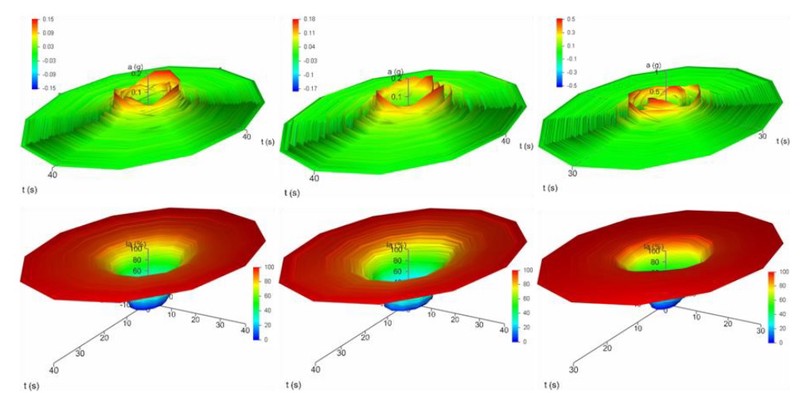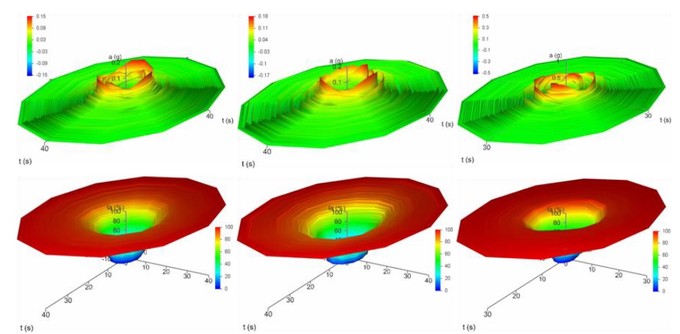
Abstract
Research of 2D and 3D models of frame building system according to the performances for the seismic action, and in accordance with the Performance-Based Earthquake Engineering (PBEE) methodology is presented in this doctoral dissertation. Research can be classified into four distinctly different areas: research in the field of ground motion record and response spectra, research in the field of nonlinear response of 2D model system frameworks that participate in building structural system framework (decomposed or treated as independent entities), research in the field of nonlinear response of 3D model frameworks and research in the field of the relationship of building capacity/seismic demand of 2D and 3D model frameworks. Research in the field of ground motion record is based on the application of natural earthquakes and artificial earthquakes. Previously, the two-componential ground motion records of natural earthquakes are selected and downloaded from the PEER GMDB database. Artificial ground motion records were considered as incomplete and complete non-stationary artificial accelerograms, whereby when creating complete non-stationary artificial accelerograms the analysis of seismic hazard is taken into consideration. The signal processing theory is used for analysis of accelerograms: formatting, converting, scaling, calculation, processing, spectral matching, filtering, generating and transformation. The process of generating inter-components of accelerograms by angles is carried out by rotating components of accelerograms in the fault parallel and fault normal direction. The ground motion record surface is created integrating inter-components of accelerograms. Based on the generated inter-components of the accelerograms the response spectra are developed and integrated into the response spectra surface. For all accelerograms and response spectra intensity measures were analyzed and the intensity measure envelopes were created. The research examined the aspects of scaling and spectral matching of accelerograms and their impact on the form of the response spectra surface. Research in the field of nonlinear response of 2D model system frameworks is based on the application of the beam finite elements, whose cross-section is discretized into fibers and which take into account the development of inelastic deformations. The general models of the pushover curves are defined, which served as a basis for a further consideration in this doctoral dissertation: highly ductile, highly or medium ductile, low or brittle behavior of buildings and transitional category. Also the classification of the pushover curves is implemented by variation of ductility, ductility in the field of stiffening/softening and coefficient of the relation of stiffness in nonlinear and linear domain. By applying these three parameters the set of typological model of the pushover curves is generated for 2D and 3D models of framework buildings. Research the type of distribution of lateral seismic loads for the NSPA pushover analysis was conducted considering the solutions obtained from the INDA analysis of earthquakes. The parabolic distribution is proposed as an alternative to the uniform and equivalent. The advantage of this distribution is demonstrated by comparing with the solution obtained from the regression analysis for a group of earthquakes or discrete values of the INDA analysis. Also, research has found that the application of the pushover curve for the uniform distribution of the lateral seismic loads is achieved quite good coverage of the INDA envelope in the capacity domain. Exploring the impact of the TU (total updating), IU (incremental updating) and HU (hybrid updating) is discussed for 2D model system frameworks, where the highest quality solutions are obtained for the NSPA-DBA analysis, compared to the INDA analysis. In order to determine the required number of the NDA analysis within one INDA analysis, a method is developed based on the solution obtained from the NSPA analysis. On the other hand, in order to predict a solution that is obtained from the INDA analysis of 2D and 3D models of framework buildings with the possibility of considering the response of the system in the capacity domain, but not significantly increasing the time required to process, the Hybrid Incremental Nonlinear Static-Dynamic Analysis (HINSDA) is developed. Higher values of drifts are obtained in a case of application of PGA-IDRmax parameters, than in a case of application of PGA-DR parameters. The least deviation of the HINSDA curve to the INDA curve is obtained using the third UBEPKHS constitutive model, while the maximum deviation is obtained using the first UBEPKHS constitutive model. Research in the field of non-linear response of 3D models of framework buildings is based on the application of the beam finite elements, while at the ends of the beams and columns are applied plastic hinges which enable the development of inelastic deformations. Effects of existence of interstorey plates were modeled using the link elements. Given that in 3D models of framework buildings nonlinear response is considering using the pushover curves for different angles of seismic actions, the pushover surface is obtained by integrating the pushover curves for the NSPA and the INDA (IDA) analysis. The general model of the pushover surface is shown and some specific models of the pushover surfaces are pointed. The typological models of NSPA pushover surfaces are defined as a function of variations in ductility, ductility in the field of stiffening/softening and coefficient of the relation of stiffness in nonlinear and linear domain for one and two main directions. Generally considering, the four groups of pushover surfaces are identified: rotationally polysymmetrice at a base, monosymmetric at a base, bisymmetric at a base and asymmetric at a base. Introducing the ductility area coefficient it is possible to analyze the performance of 3D models of framework buildings taking into account the ductility in all directions or angles of seismic actions. Research has shown that the INDA (IDA) pushover surface has a different shape, compared to the NSPA pushover surface, since the different intensity measure and engineering demand parameter are applied. In order to analyze the performance of 4x6x3, 4x6x5-13, 15x4x4, 15x4x4-6 and 9x6x5-12 3D models of framework buildings, monitoring of the plastic hinges development at incremental stages was conducted, which is presented as isosurfaces in polar coordinates. Also, the implemented curves are discussed in polar coordinates for a drift, the relative value of the total base shear force of building and ductility. Research found that in all models of buildings are realized smaller or something larger maximum global drifts DRmax from global drifts DRIO, for the IO performance level according to the FEMA regulations. The higher ductility class is easier to realize for buildings with a larger number of storeys, and increase in irregularities at a base reduces ductility. Considering the realized NSPA pushover surface in spatial coordinates, for all 3D models of framework buildings, was found that stiffness in the nonlinear domain Kn≈0 is almost horizontal or slightly positive, except in certain cases where with increasing nonlinear deformations stiffness becomes negative Kn<0. For 9x6x5-12 3D model of framework building was realized significantly lower maximum relative value of the total base shear force of building in relation to the relative value of the total base shear force of building for 4x6x3, 4x6x5-13, 15x4x4 and 15x4x4-6 3D models of framework buildings. It is a direct consequence of calculation of the seismic action according to the SRP regulations. In relation to the curve of the relative value of the total base shear force of building (V/W)adeq for maximum global drift DRmax calculated by the NSPA analyses that are circular or nearly circular in shape, curve of the relative spectral acceleration Sa/Sa,y calculated by the IDA analyses are ellipsoidal or more complex forms. In the initial part of research of the relationship of building capacity/seismic demand of 2D and 3D model frameworks the general models of relations for the pushover curves and the demand curves (BR/SD) were defined, which served as a basis for further consideration of target displacements. In the second part of research the Iterative Displacement Coefficient Method (IDCM) was developed, which was used for analyses of the target displacements. Based on the IDCM method and numerical tests conducted on the pushover curves for standardized models of responses and the random response function, it is found that the values of drifts are in very satisfactory agreement according to the IDCM and the NDA analyses. Also, the minimum deviation of the relative value of the total base shear force of building realized by the IDCM method, compared to the solutions obtained by the NDA method at levels of target displacements (V/W)t. In the third part of research the level of seismic demands of 3D models of framework buildings were conducted, and is presented through the target displacement envelope and drifts: for performance levels, mean, median of target displacement and maximum displacement. Relative values of the total base shear force of building for target displacements and maximum global drift are also shown. Based on the defined target displacement envelope a series of coefficients were developed which are used to assess the performance of 3D models of framework buildings. The performances of buildings are analyzed also using the developed global drift surface and interstorey drift surface. In the fourth part, based on the Nonlinear Static Pushover Analysis - Damage Mechanisms-Based Design (NSPA-DMBD) and research on the model of framework system, indicated that even at the initial NSPA analysis unfavorable fracture mechanism was through the ultimate concrete strain. At lower storeys, according to the NSPA-DMBD method, the values of interstorey drifts are reduced, while at the higher storeys are increased thus balancing the response of the structure.
